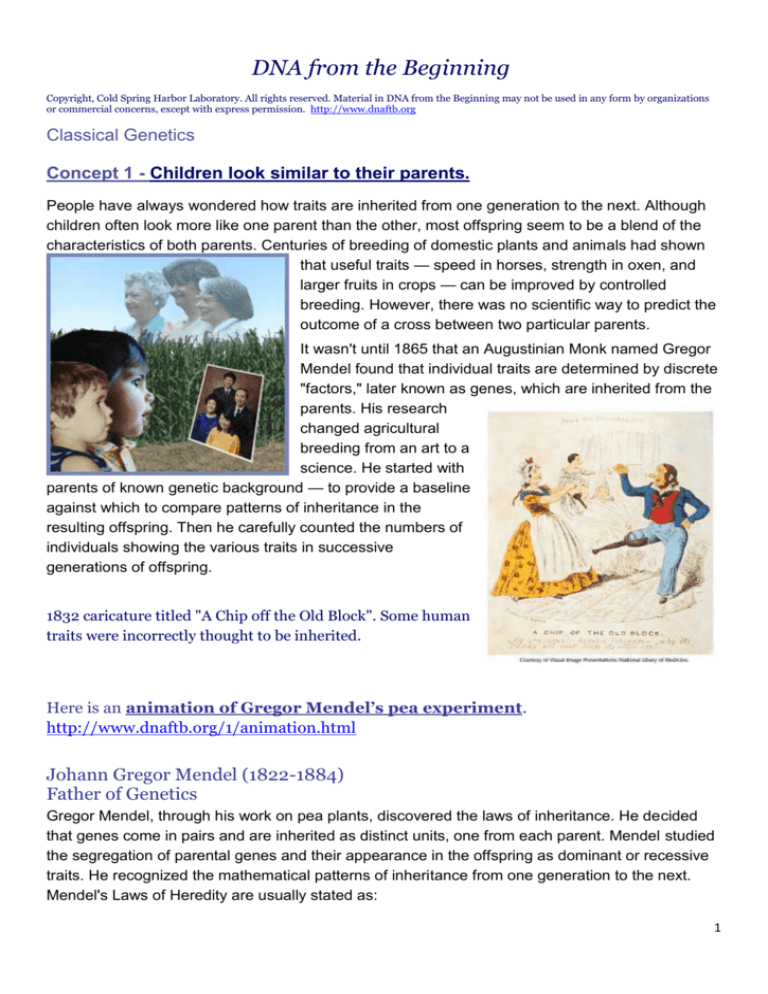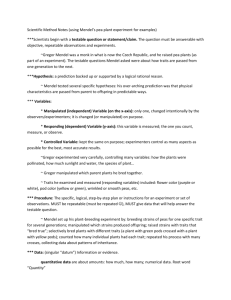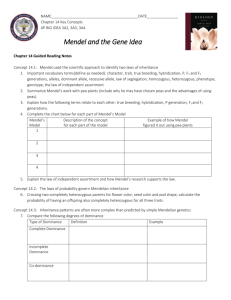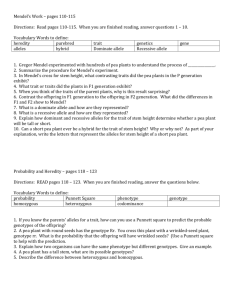
DNA from the Beginning
Copyright, Cold Spring Harbor Laboratory. All rights reserved. Material in DNA from the Beginning may not be used in any form by organizations
or commercial concerns, except with express permission. http://www.dnaftb.org
Classical Genetics
Concept 1 - Children look similar to their parents.
People have always wondered how traits are inherited from one generation to the next. Although
children often look more like one parent than the other, most offspring seem to be a blend of the
characteristics of both parents. Centuries of breeding of domestic plants and animals had shown
that useful traits — speed in horses, strength in oxen, and
larger fruits in crops — can be improved by controlled
breeding. However, there was no scientific way to predict the
outcome of a cross between two particular parents.
It wasn't until 1865 that an Augustinian Monk named Gregor
Mendel found that individual traits are determined by discrete
"factors," later known as genes, which are inherited from the
parents. His research
changed agricultural
breeding from an art to a
science. He started with
parents of known genetic background — to provide a baseline
against which to compare patterns of inheritance in the
resulting offspring. Then he carefully counted the numbers of
individuals showing the various traits in successive
generations of offspring.
1832 caricature titled "A Chip off the Old Block". Some human
traits were incorrectly thought to be inherited.
Here is an animation of Gregor Mendel’s pea experiment.
http://www.dnaftb.org/1/animation.html
Johann Gregor Mendel (1822-1884)
Father of Genetics
Gregor Mendel, through his work on pea plants, discovered the laws of inheritance. He decided
that genes come in pairs and are inherited as distinct units, one from each parent. Mendel studied
the segregation of parental genes and their appearance in the offspring as dominant or recessive
traits. He recognized the mathematical patterns of inheritance from one generation to the next.
Mendel's Laws of Heredity are usually stated as:
1
1) The Law of Segregation: Each inherited trait is defined by a gene pair. Parental genes are
randomly separated to the sex cells so that sex cells contain only one gene of the pair. Offspring
therefore inherit one genetic allele from each parent when sex cells unite in fertilization.
2) The Law of Independent Assortment: Genes for different traits are sorted separately from
one another so that the inheritance of one trait is not dependent on the inheritance of another.
3) The Law of Dominance: An organism with alternate forms of a gene will express the form that
is dominant.
The genetic experiments Mendel did with pea plants took him eight years (1856-1863) and he
published his results in 1865. During this time, Mendel grew over 10,000 pea plants, keeping track
of progeny number and type. Mendel's work and his Laws of Inheritance were not appreciated in
his time. It wasn't until 1900, after the rediscovery of his Laws, that his experimental results were
understood.
Concept 2 - Genes come in pairs.
Rather than looking at the pea plant as a whole, Mendel
focused on seven individual traits that he could readily
distinguish. He found that each trait has two alternate forms.
For example, seed color can be green or yellow. By analyzing
the results of various crosses, Mendel concluded that each
alternative form of a trait is specified by alternative forms of a
gene.
To follow the inheritance of genes from parent to child, Mendel
first needed to be sure which genes each parent carried. Since pea plants are naturally selffertilizing, "pure-bred" strains were readily available. Each strain contained only one form of the
gene that determined a trait. Pure-bred plants with yellow seeds only produced offspring with
yellow seeds. Pure-bred plants with green seeds only produced offspring with green seeds. From
the results of further experiments, Mendel reasoned that
pure-bred plants must have two copies of the same
gene for each trait.
Peas are a popular crop and many varieties existed for
Mendel to work with. This is an illustration from Album
Bernay (1876-93), and shows some of the pea traits
Mendel used.
Here is an animation of Mendel’s experiment.
http://www.dnaftb.org/2/animation.html
To get a feel for Mendel’s experiments you can do
the problem at
http://www.dnaftb.org/2/problem.html
2
Concept 3 - Genes don't blend.
Offspring appear to be a mixture of parental characteristics.
However, Mendel found that this is not true for the pea plant
traits that he chose to study. Pure-bred pea plants when
crossed did not produce offspring with blended traits.
For example, one might expect that a cross between purebred green-seeded and pure-bred yellow-seeded pea plants
to produce offspring with seeds of an intermediate greenyellow color. After all, color blending happens when paint is
mixed together. However, Mendel found that this cross
produced offspring with only one color — yellow. No
intermediate blends were seen, and the green color seemed
to have disappeared.
Here is an animation showing this concept. http://www.dnaftb.org/3/animation.html
Here is a problem to help you remember the concept http://www.dnaftb.org/3/problem.html
Concept 4 - Some genes are dominant.
Mendel believed that genes behave like atoms that
compose a pure substance. Genes can combine in
various ways, but always maintain their distinct identities.
For example, in a cross between two pure-bred parents
with different traits like seed color, the hybrid offspring
would have both the gene alternates for green and
yellow seed color.
Why then do offspring from such a cross have only
yellow seeds? Mendel proposed that although both gene
alternates are present, there is no blending of color
because the gene alternate for yellow is "dominant" over
the gene alternate for green. The dominant trait is seen
whenever a single copy of its gene is inherited. When he crossed the hybrid offspring, green
seeds reappeared in the next generation. Mendel reasoned that the "recessive" green trait is
shown only when a copy of the recessive gene form is inherited from each parent.
Animation at http://www.dnaftb.org/4/animation.html
A review problem is at http://www.dnaftb.org/4/problem.html
3
Concept 5 - Genetic inheritance follows rules.
When Mendel said that each trait is determined by a pair of genes,
it presented a problem. If parents pass on both copies of a gene
pair, then offspring would end up with four genes for each trait.
Mendel deduced that sex cells — sperm and eggs — contain only
one parental gene of each pair. The half-sets of genes contributed
by sperm and egg restore a whole set of genes in the offspring.
Mendel found that different gene combinations from the parents
resulted in specific ratios of dominant-to-recessive traits. The
results of a cross between two hybrid parents — each carrying
one dominant and one recessive gene — were key to his synthesis. For example, a cross between
two yellow-seed hybrids produces three times as many yellow seeds as green seeds. This is
Mendel's famous 3 to 1 ratio.
Animation at http://www.dnaftb.org/5/animation.html
A review problem is at http://www.dnaftb.org/5/problem.html
Concept 6 - Genes are real things.
Mendel published his research, Experiments in Plant
Hybridization, in 1865 and sent reprints to prominent scientists
in several countries. However, his abstract idea of genes was
not accepted by scientists of his time (They couldn’t see genes).
So, Mendel's work was not accepted until 1900, when three
European scientists independently confirmed his results.
By that time, there was strong evidence that cells are the basic
units of life. Biological stains were developed that highlighted
structures within cells — including thread-like chromosomes.
Different organisms proved to have different numbers of
chromosomes, suggesting that they might carry information
specific for each life form. This study of the cell and chromosomal behavior was to give Mendel's
abstract genetic work the physical context it needed.
Animation at http://www.dnaftb.org/6/animation.html
Make that you look at the review problem is at http://www.dnaftb.org/6/problem.html
4
Concept 7 - All cells arise from other cells.
For centuries people accepted the "spontaneous
generation" of life from non-living matter. When this
idea was finally dismissed in the mid-1800s, it became
clear that all life must come from pre-existing life —
by reproduction. If cells are the units of life, they too
must have a way to reproduce that keeps the proper
chromosome number in each cell.
About a decade after the publication of Mendel's paper,
scientists carefully documented the behavior of
chromosomes during cell division (mitosis), using dyes
to make them visible. First, each chromosome copies
itself and the duplicates line up at the mid-line of the
cell. Then, duplicate copies of each chromosome are
pulled toward opposite ends of the cell. Finally, the cell splits at the equator, producing two new
cells with identical sets of chromosomes.
Walther Flemming (1843-1905) was one of the first to study chromosomes. Cell division had been
described as early as 1842 by Carl Nägeli, but he thought it was a strange event. Flemming was
the first to detail the chromosomal movements in the process of mitosis. In 1879, Flemming used
aniline dyes to stain cells of salamander embryos. He was able to see the threadlike material as
the cells divide. He described the whole process in his book, which was published in 1882. Much
of what we know today about mitosis started with Flemming's observations. He saw that
chromosomes were "doubled" when they appeared in prophase, and "solved" the problem of
chromosomal separating between mother and daughter cells. This was important for later work in
meiosis and the chromosomal theory of inheritance.
Photomicrograph of a cell dividing: nucleus is
visible as dark staining organelle
Cell dividing: chromosomes are visible and
lined up at the plane of division.
5
Cell dividing: chromosomes are being pulled
toward the cellular poles.
Cell dividing: mother cell divides resulting in
two daughter cells each with its own nucleus.
Animation at http://www.dnaftb.org/7/animation.html
The review problem is at http://www.dnaftb.org/7/problem.html
Concept 10 - Chromosomes carry genes.
Thomas Hunt Morgan and his students at
Columbia University started the era of modern
genetics when they showed the physical basis of
heredity. The Columbia group studied inheritance
in the common fruit fly. Unlike Mendel, who found
readily identifiable traits, they spent months
searching for a fly with any unique trait that could
be studied.
Finally they discovered a single white-eyed male fly, which
stood out from its normal, red-eyed peers. A cross between
the mutant male and a red-eyed female produced only redeyed offspring. White-eyed mutants reappeared in the
following generation — the classic pattern of a recessive trait.
However, the white-eyed trait was seen exclusively in males
of the second generation. They concluded that white-eyed is a
sex-linked recessive trait. The gene for eye color must be
physically located on the X chromosome.
Animation at http://www.dnaftb.org/10/animation.html
The review problem is at http://www.dnaftb.org/10/problem.html
6
Concept 13 - Mendelian laws apply to human beings.
Although Mendel's laws were first tested in pea plants and fruit flies, evidence quickly mounted
that they applied to all living things. Just as mutations had provided keys to understanding fruit fly
genetics, pedigrees of families affected by diseases provided many of the first examples of
Mendelian inheritance in humans.
Recessive inheritance was first described for the disorders alkaptonuria (1902) and albinism
(1903). Among the first dominant disorders discovered were brachydactyly (short fingers, 1905),
congenital cataracts (1906), and Huntington's chorea (1913). Duchenne muscular dystrophy
(1913), red-green color blindness (1914), and hemophilia (1916) were the first sex-linked disorders.
The simple concept of eye color inheritance — brown is dominant, blue is recessive — was
published in 1907; however, scientists now believe that several genes are involved.
Animation at http://www.dnaftb.org/13/animation.html
The review problem is at http://www.dnaftb.org/13/problem.html
7

![Biology Chapter 3 Study Guide Heredity [12/10/2015]](http://s3.studylib.net/store/data/006638861_1-0d9e410b8030ad1b7ef4ddd4e479e8f1-300x300.png)






